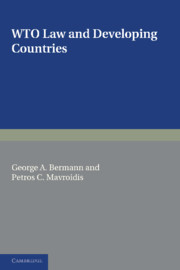Book contents
- Frontmatter
- Contents
- Contributors
- Developing Countries in the WTO System
- 1 The Legal Status of Special and Differential Treatment Provisions under the WTO Agreements
- 2 Trade Preferences to Small Developing Countries and the Welfare Costs of Lost Multilateral Liberalization
- 3 China in the WTO 2006: “Law and Its Limitations” in the Context of TRIPS
- 4 Developing Countries in the WTO Services Negotiations: Doing Enough?
- 5 Developing Countries and the Protection of Intellectual Property Rights: Current Issues in the WTO
- 6 Participation of Developing Countries in the WTO – New Evidence Based on the 2003 Official Records
- 7 Developing Countries and GATT/WTO Dispute Settlement
- 8 Representing Developing Countries in WTO Dispute Settlement Proceedings
- 9 Compensation and Retaliation: A Developing Country's Perspective
- 10 A Preference for Development: The Law and Economics of GSP
- 11 The GSP Fallacy: A Critique of the Appellate Body's Ruling in the GSP Case on Legal, Economic, and Political/Systemic Grounds
- 12 Is the WTO Doing Enough for Developing Countries?
- Index
6 - Participation of Developing Countries in the WTO – New Evidence Based on the 2003 Official Records
Published online by Cambridge University Press: 04 August 2010
- Frontmatter
- Contents
- Contributors
- Developing Countries in the WTO System
- 1 The Legal Status of Special and Differential Treatment Provisions under the WTO Agreements
- 2 Trade Preferences to Small Developing Countries and the Welfare Costs of Lost Multilateral Liberalization
- 3 China in the WTO 2006: “Law and Its Limitations” in the Context of TRIPS
- 4 Developing Countries in the WTO Services Negotiations: Doing Enough?
- 5 Developing Countries and the Protection of Intellectual Property Rights: Current Issues in the WTO
- 6 Participation of Developing Countries in the WTO – New Evidence Based on the 2003 Official Records
- 7 Developing Countries and GATT/WTO Dispute Settlement
- 8 Representing Developing Countries in WTO Dispute Settlement Proceedings
- 9 Compensation and Retaliation: A Developing Country's Perspective
- 10 A Preference for Development: The Law and Economics of GSP
- 11 The GSP Fallacy: A Critique of the Appellate Body's Ruling in the GSP Case on Legal, Economic, and Political/Systemic Grounds
- 12 Is the WTO Doing Enough for Developing Countries?
- Index
Summary
abstract: The WTO takes pride in being a “Member-driven” organization, with decisions taken by consensus among all Member states. But how active are the various Member states in reality? In particular, to what extent do developing countries participate in the proceedings – and if not, why not? This chapter offers new evidence on this subject based of WTO official records for 2003. Data show that the activity level is highly uneven and is correlated closely with size and income levels. The relative silence of smaller and poorer member states is especially telling at the technical level (Committees and Working Groups) where the substantive work is carried out.
Introduction
The WTO is run by its member governments. All major decisions are made by the membership as a whole, either by ministers (who meet at least once every two years) or by their ambassadors or delegates (who meet regularly in Geneva). Decisions are normally taken by consensus. In this respect, the WTO is different from some other international organizations such as the World Bank and International Monetary Fund. In the WTO, power is not delegated to a board of directors or the organization's head.
WTO (2003), Understanding the WTO, p. 101As suggested by the opening paragraph quoted from a glossy brochure of the World Trade Organization, the WTO takes considerable pride in being a Member-driven organization with decisions taken by consensus among all Member states. From a normative point of view, this is how the organization is supposed to operate.
- Type
- Chapter
- Information
- WTO Law and Developing Countries , pp. 146 - 194Publisher: Cambridge University PressPrint publication year: 2007
- 2
- Cited by

